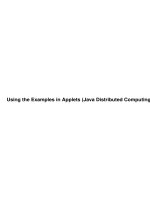Tài liệu Testkiller 640-503 Ed2 ppt
Bạn đang xem bản rút gọn của tài liệu. Xem và tải ngay bản đầy đủ của tài liệu tại đây (285.19 KB, 29 trang )
CISCO
STUDY GUIDE
Building Scalable
Cisco Networks (BSCN)
Exam 640-503
Edition 2
www.testkiller.com
Congratulations!!
You have purchased a Testkiller, Ltd Study Guide.
This study guide is a selection of questions and answers similar to the ones you
will find on the official CCNP 640-503 exam. Study and memorize the following
concepts, questions and answers for approximately 15 to 20 hours and you will be
prepared to take the exams. We guarantee it!
Remember, average study time is 15 to 20 hours and then you are ready!!!
GOOD LUCK!
DISCLAIMER
This study guide and/or material is not sponsored by, endorsed by or affiliated with Cisco Sys-
tems, Inc. Cisco®, Cisco Systems®, CCDA™, CCNA™, CCDP™, CCNP™, CCIE™, CCSI™,
the Cisco Systems logo and the CCIE logo are trademarks or registered trademarks of Cisco Sys-
tems, Inc. in the United States and certain other countries. All other trademarks are trademarks
of their respective owners
.
Guarantee
If you use this study guide correctly and still fail the exam, send your official score
notice and mailing address to:
Testkiller, Ltd
8200 Pat Booker Rd. #368
San Antonio, TX 78233
We will gladly refund the cost of this study guide. However, you will not need this
guarantee if you follow the above instructions.
This material is protected by copyright law and international treaties. Unauthor-
ized reproduction or distribution of this material, or any portion thereof, may re-
sult in severe civil and criminal penalties, and will be prosecuted to the maximum
extent possible under law.
Copyright 2001 Testkiller, Ltd. All Rights Reserved.
www.testkiller.com
Table of Contents
Routing Principles........................................................................................................................... 1
Routing Metric............................................................................................................................ 1
RIP Routing Metrics ............................................................................................................... 1
IGRP Routing Metrics ............................................................................................................1
Classful Routes ....................................................................................................................... 1
Classless Routing.................................................................................................................... 1
Distance Vector Operation...................................................................................................... 1
Convergence ............................................................................................................................... 1
EIGRP Convergence...............................................................................................................1
OSPF Convergence................................................................................................................. 2
IP Addresses.................................................................................................................................... 2
Current challenges in IP Addressing........................................................................................... 2
IP Addressing Solutions.............................................................................................................. 2
Hierarchical Addressing.......................................................................................................... 2
Variable Length Subnet Masks............................................................................................... 2
Route Summarization.............................................................................................................. 2
CIDR....................................................................................................................................... 3
Redistribution Implementation Guidelines............................................................................. 3
NAT ........................................................................................................................................ 3
Using IP Unnumbered Serial Interface....................................................................................... 3
Server Location........................................................................................................................... 3
OSPF............................................................................................................................................... 3
Configuring OSPF in a Single Area............................................................................................ 3
OSPF Operation in a Broadcast Multiaccess Topology ......................................................... 4
OSPF Startup .......................................................................................................................... 4
OSPF over NBMA Topology ................................................................................................. 4
NBMA Mode Neighborship ................................................................................................... 5
Point-to-Multipoint Mode Neighborship ................................................................................ 5
Interconnecting Multiple OSPF Areas........................................................................................ 5
Multiple OSPF Areas.............................................................................................................. 5
Types of Routers..................................................................................................................... 6
Types of Areas ........................................................................................................................ 6
Supporting Route Summarization........................................................................................... 6
EIGRP............................................................................................................................................. 6
Configuring EIGRP .................................................................................................................... 6
EIGRP Operation .................................................................................................................... 6
EIGRP Packets........................................................................................................................ 6
EIGRP Reliability ................................................................................................................... 7
Topology Table....................................................................................................................... 7
Configuring EIGRP ................................................................................................................ 7
EIGRP Load Balancing........................................................................................................... 7
EIGRP and WAN Links.......................................................................................................... 7
EIGRP Link Utilization ..........................................................................................................7
www.testkiller.com
Using EIGRP in a Scalable Network...................................................................................... 7
BGP................................................................................................................................................. 8
Configuring Basic Border Gateway Protocol ............................................................................. 8
BGP Use.................................................................................................................................. 8
When to use BGP.................................................................................................................... 8
When not to use BGP.............................................................................................................. 8
BGP Peers or Neighbors ......................................................................................................... 8
Policy-Based Routing ............................................................................................................. 8
Well Known Attributes...........................................................................................................8
Optional Attributes.................................................................................................................. 9
Defined BGP Attributes..........................................................................................................9
BGP Synchronization.............................................................................................................. 9
BGP Message Types...............................................................................................................9
Implementing BGP in Scalable Networks ................................................................................ 10
Route Reflectors.................................................................................................................... 10
Policy Control and Prefix Lists............................................................................................. 10
Optimizing Routing Update Operation......................................................................................... 10
Redistribution............................................................................................................................ 10
Policy-based Routing................................................................................................................ 10
Calculating cost for external routes .......................................................................................... 10
www.testkiller.com
GFI - Security & Communication tools for NT/2000: FAXmaker fax server software, Mail essentials email content checking &
anti-virus software and LANguard network security software. />
1
Key Concepts
Building Scalable Cisco Networks (BSCN)
Routing Principles
Routing is a relay process in which items are forwarded from one location to another. The
mechanism of learning and maintaining awareness of the network topology is considered to be
the routing function.
Routing Metric
In a routed network the routing process relies on the routing protocol to maintain a loop-free to-
pology and to locate the best path to every destination network.
RIP Routing Metrics
RIP is a commonly used routing protocol in small to medium sized TCP/IP networks.
IGRP Routing Metrics
Cisco’s IGRP is a commonly used routing protocol in medium to large sized TCP/IP networks.
IGRP uses a composite metric, based upon bandwidth, delay, reliability, load, and maximum
transmission unit (MTU).
Classful Routes
Classful routing protocols, such as RIPv1 and IGRP, exchange routes to subnetworks within the
same major Class (A, B or C) network. Classful routing is the result of subnet masks not being
included in the routing advertisements generated by most distance vector routing protocols.
Classless Routing
Classless routing protocols can be considered second-generation protocols because they are de-
signed to deal with some of the limitations of the earlier classful protocols.
Distance Vector Operation
The periodic routine routing updates generated by most distance vector routing protocols go only
to directly connected routing devices.
Convergence
In a routed network, the routing process in each router must maintain a loop-free single path to
each possible destination logical network. When all the routing tables are synchronized and each
contains a usable route to each destination network, the network is converged.
EIGRP Convergence
A router running EIGRP uses reliable multicast messages when it sends queries and updates to
other routers.
www.testkiller.com
GFI - Security & Communication tools for NT/2000: FAXmaker fax server software, Mail essentials email content checking &
anti-virus software and LANguard network security software. />
2
OSPF Convergence
A router running OSPF uses a multicast address to propagate LSAs. LSA is state information
about a link or a network.
IP Addresses
Current challenges in IP Addressing
An IP address consists of a 32-bit number with two components: a network address and a node.
The incredible growth of the Internet has resulted in following challenges:
• IP address exhaustion
• Routing table growth and manageability
IP Addressing Solutions
Solutions have been developed to slow the depletion of IP addresses and to reduce the number of
Internet route table entries by enabling more hierarchical layers in an IP address. These solutions
include the following:
• Subnet masking
• Address allocation for private internets
• Network Address Translation (NAT)
• Hierarchical addressing
• Variable-length subnet masks (VLSMs)
• Route summarization
• Classless Interdomain Routing (CIDR)
Hierarchical Addressing
The benefits of hierarchical addressing are:
• Reduced number of routing table entries
• Efficient allocation of addresses
Variable Length Subnet Masks
The VLSMs are commonly used to maximize the number of possible addresses available for a
network. The benefits if VLSMs are:
• Even more efficient use of IP addresses
• Greater capability to use route summarization
Route Summarization
Route summarization can reduce the number of routes that a router must maintain because it is a
method of representing a series of network numbers in a single summary address.
www.testkiller.com
GFI - Security & Communication tools for NT/2000: FAXmaker fax server software, Mail essentials email content checking &
anti-virus software and LANguard network security software. />
3
Cisco routers manage route summarization in two ways:
• Sending route summaries
• Selecting routes from route summaries
CIDR
CIDR is a mechanism developed to help alleviate the problem of exhaustion of IP addresses and
growth of routing tables.
Redistribution Implementation Guidelines
• Be familiar with your network and your network traffic
• Do not overlap routing protocols
• One-way redistribution
• Two-way redistribution
NAT
Network Address Translation can be used to merge two large networks without having to re-
address the whole network. Another function of NAT is overloading inside global addresses.
This process allows several inside addresses to use a single IP address. NAT can also use a pool
of addresses or multiple interfaces.
Using IP Unnumbered Serial Interface
To enable IP processing on a serial interface without assigning an explicit IP address to the inter-
face, use the ip unnumbered type number interface configuration command. In the command
type number indicates the type and number of another interface on which the router has an as-
signed IP address.
Server Location
The server location is located in several ways:
• A single server on a single remote medium
• Multiple servers on a single remote medium, sometimes called a server farm
• Multiple servers on multiple remote media
OSPF
Configuring OSPF in a Single Area
OSPF is a link-state technology, as opposed to a distance vector technology such as Routing In-
formation Protocol (RIP). The OSPF protocol performs the two primary functions of every rout-
ing protocol algorithm: path selection and path switching.
The OSPF addresses the following issues:
www.testkiller.com
GFI - Security & Communication tools for NT/2000: FAXmaker fax server software, Mail essentials email content checking &
anti-virus software and LANguard network security software. />
4
• Speed of convergence
• Support for variable-length subnet masks (VLSMs)
• Network Reachability
• Use of bandwidth
• Method for path selection
Topologies found in OSPF are:
• Broadcast multiaccess topologies
• Point-to-point topologies
• Nonbroadcast multiaccess (NBMA) topologies
OSPF Operation in a Broadcast Multiaccess Topology
Because OSPF topology is dependent on the status of a link between two routers, neighbor
routers must recognize each other on the network before they can share information. This proc-
ess is done using the Hello Protocol. The information contained in a Hello Packet is as follows:
• Router ID
• Hello and dead intervals
• Neighbors
• Area-ID
• Router priority
• DR and BDR IP address
• Authentication password
• Stub area flag
The DR and BDR add value to the network in the following ways:
• Reducing routing update traffic
• Managing link-state synchronization
OSPF Startup
The steps involved when routers running OSPF come up on a network.
1. Exchange Process
2. Discovering Routes
OSPF over NBMA Topology
OSPF runs in two official modes in NBMA topologies:
• Nonbroadcast Multiaccess (NBMA)
• Point-to-Multipoint
www.testkiller.com
GFI - Security & Communication tools for NT/2000: FAXmaker fax server software, Mail essentials email content checking &
anti-virus software and LANguard network security software. />
5
NBMA Mode Neighborship
Consider the following before using this mode:
• Full mesh and direct communication
• Stability of the network
Point-to-Multipoint Mode Neighborship
This mode has the following properties.
• Does not require a fully meshed network
• Does not require static neighbor configuration
• Uses one IP subnet
• Duplicates LSA packets
Configuring OSPF over NBMA Topology
• RFC –compliant Modes
NBMA Mode
Point-to-multipoint Mode
• Cisco-defined Modes
Point-to-multipoint nonbroadcast mode
Broadcast mode
Point-to-point mode
Interconnecting Multiple OSPF Areas
Multiple OSPF Areas
The following areas need to be addresses.
Frequent calculations of the shortest path first (SPF) algorithm
Large routing table
Large link-state table
The hierarchical topology of OSPF has the following advantages.
Reduced frequency of SPF calculations
Smaller routing tables
Reduced link-state update (LSU) overhead
www.testkiller.com
GFI - Security & Communication tools for NT/2000: FAXmaker fax server software, Mail essentials email content checking &
anti-virus software and LANguard network security software. />
6
Types of Routers
1. Internal Router
2. Backbone Router
3. Area Border Router
4. Autonomous System Boundary Router (ASBR)
Types of Areas
The characteristics that you assign an area control the type of route information that it receives.
The possible area types include the following.
Standard area
Backbone area
Stub area
Totally stubby area
Not-so-stubby area
Supporting Route Summarization
Summarization is the consolidation of multiple routes into a single advertisement. With summa-
rization, only summarized routes will propagate into the backbone. Two types of summarization
exist, as follows:
1. Interarea route summarization
2. External route summarization
EIGRP
Configuring EIGRP
EIGRP is a Cisco owned protocol that combines the advantages of link-state and distance vector
routing protocols. This hybrid protocol has the following features:
Rapid convergence
Reduced bandwidth usage
Multiple network layer support
EIGRP Operation
Elements of EIGRP operation are:
EIGRP Packets
EIGRP neighbor relationship
EIGRP Packets
EIGRP uses the following five types of packets:
www.testkiller.com
GFI - Security & Communication tools for NT/2000: FAXmaker fax server software, Mail essentials email content checking &
anti-virus software and LANguard network security software. />
7
Hello
Update
Queries
Replies
ACK
EIGRP Reliability
EIGRPs reliability mechanism ensures delivery of critical route information to neighboring
routers. This information is required to allow EIGRP to maintain a loop-free topology. All pack-
ets carrying routing information are sent reliably.
Topology Table
When the router dynamically discovers a new neighbor, it sends an update about the routes that it
knows to its new neighbor and receives the same from the new neighbor. These updates populate
what is known as the Topology Table.
Configuring EIGRP
Perform the following steps to configure EIGRP for IP.
1. Enable EIGRP and define the autonomous system.
2. Indicate which networks are parts of the EIGRP autonomous system.
3. If using serial links especially for the frame relay or SMD define the bandwidth of a link
for the purpose of sending routing update traffic on the link.
EIGRP Load Balancing
Load balancing is the capability of a router to distribute the traffic over all its network ports that
are the same distance from the destination address.
EIGRP and WAN Links
EIGRP is scalable on both point-to-point links and NBMA multipoint and point-to-point links. A
solid understanding of EIGRP operation coupled with knowledge of link speeds can yield an ef-
ficient, reliable and scalable router configuration.
EIGRP Link Utilization
By default EIGRP will use up to 50 percent of the bandwidth declared on an interface or subin-
terface. This percentage can be adjusted.
Using EIGRP in a Scalable Network
The following are some of the many variables that impact network scalability.
The amount of information exchanged between neighbors
A topology change
The depth of topology
The number of alternative paths through the network









